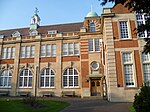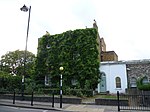Burleigh House, Enfield
Buildings and structures completed in the 17th centuryBuildings and structures demolished in 1913Demolished buildings and structures in EnglandEnfield, LondonHistory of Middlesex ... and 2 more
Houses in the London Borough of EnfieldMiddlesex

Burleigh House was a house in Enfield, near London, that was built in the mid-17th century for the lawyer James Mayoe. It was constructed on the grounds of a house once owned by the merchant Benjamin Deicrowe Jr. that Mayoe obtained from the indebted Deicrowe through legal manoeuvring. Burleigh House, which did not receive that name until the 19th-century, was particularly known for its ornate iron gates. It was demolished in 1913 and shops and a cinema built on its grounds but is remembered in the modern Burleigh Way.
Excerpt from the Wikipedia article Burleigh House, Enfield (License: CC BY-SA 3.0, Authors, Images).Burleigh House, Enfield
Silver Street, London Southbury (London Borough of Enfield)
Geographical coordinates (GPS) Address Phone number Website Nearby Places Show on map
Geographical coordinates (GPS)
| Latitude | Longitude |
|---|---|
| N 51.653 ° | E -0.083 ° |
Address
Enfield Grammar School
Silver Street
EN1 3EF London, Southbury (London Borough of Enfield)
England, United Kingdom
Open on Google Maps










